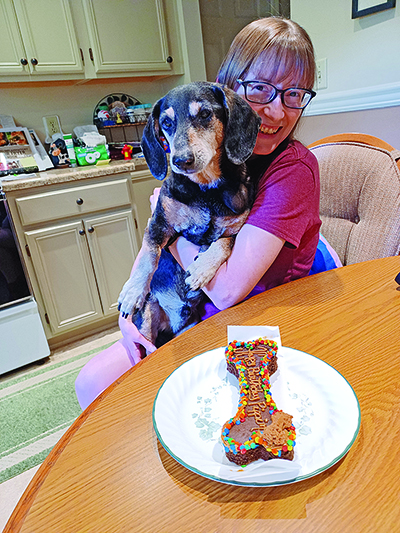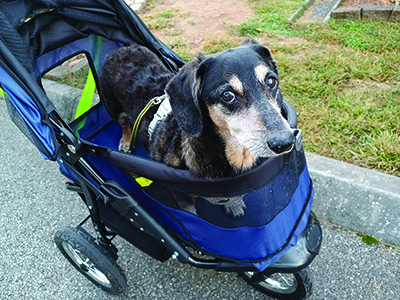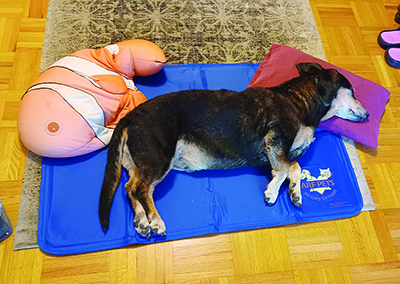Living with Cushing’s
The space under the bed was so low that Pippin had to duck, even with his short dachshund legs. But he was determined to hide. I would crouch beside the bed and peer underneath, trying to coax him out. But he trembled with fear.
He had become afraid of the washing machine. It was a new behavior, though the machine and the sounds hadn’t changed. He also developed separation anxiety, especially if he was left alone in the evenings. We’d come home to find him crying and panting heavily as if he’d been upset for hours.
The panting became an issue. He’d seem particularly anxious at the dinner table. His hunger was insatiable and he always begged for more. He might also have been drinking more water and wanting to go out for more frequent potty breaks, but he was 13 years old. We chalked it up to age-related changes and the heat of summer.
Pippin’s semi-annual vet appointment revealed a different story. His bloodwork showed a high ALP (alkaline phosphatase). This is a possible indicator of hyperadrenocorticism, also known as Cushing’s disease. When the bloodwork was suspicious, Pippin’s vet ordered further testing. The results confirmed the diagnosis.
With Cushing’s disease, the body produces too much of a hormone called cortisol. Cortisol is produced by the adrenal glands and is essential for regulating processes including metabolism, stress response and immune function. I’ve seen it referred to as the “stress hormone.” Too much cortisol means too much stress!
In the majority of cases, including Pippin’s, Cushing’s is caused by a small tumor on the pituitary gland. This causes overproduction of ACTH (adrenocorticotropic hormone), which in turn stimulates the adrenal glands to produce more cortisol than the body needs.
Symptoms can differ for dogs with Cushing’s. Behavioral signs include increased thirst and urination, increased appetite, excessive panting and lethargy. Physical signs may include hair loss, thinning skin with possible infections, and an enlarged abdomen that results in a “pot-bellied” appearance.
Pippin only displayed some of these, but he was also diagnosed with hypertension (high blood pressure), which can occur alongside Cushing’s. We started medication for both issues. This began a process of careful, consistent monitoring with our veterinarian. We went for frequent blood pressure checks and ACTH tests. In Pippin’s case, the medication for Cushing’s worked well and quickly stabilized his bloodwork.
The blood pressure was a different story. We started on low doses of medication and saw no improvement. We slowly increased to the maximum dose for his size. We had one good reading, but it increased again at the next appointment. We switched medicines, added different ones to see if the combination would work. Nothing helped.
I grew discouraged. It was stressful for him and us to make so many trips to the vet and see no positive gains. This went on for 13 months.
I researched as much as I could to learn about managing Cushing’s, and I read online about other people’s experiences with their pets. I’m so grateful for the staff at Village Veterinary Medical Center, who are always so helpful and patient and have taken such good care of Pippin. The doctors have been willing to answer our questions and concerns and discuss best treatment options.
In the case of his blood pressure, we brought up the option of splitting the dose of his Cushing’s medication (so he’d get half in the morning and half in the evening). It was a technique I’d learned about by reading others’ stories; they suggested symptoms could be better stabilized if the dose was spread evenly throughout the day.
This, along with getting one of his blood pressure medications compounded as a liquid to get a precise dose, finally brought a breakthrough. We could tell when Pippin’s blood pressure began to come down—it was clear that he felt better. He had more energy and panted less. He just seemed more “Pippin-ish,” his personality shining through again like he was a younger pup. Sure enough, at the next appointment, his blood pressure finally registered in an acceptable range.
We settled into a new normal with Cushing’s. While the disease is managed by medication, some symptoms are just part of life now. Pippin runs hot, obviously uncomfortable when it gets too warm. His fur is coarser in texture and comes out in clumps when the weather turns warm. And he is always hungry.
We keep the house a few degrees cooler for him (while we bundle up!) and bought him a cooling mat to help moderate his temperature. He likes to munch on crushed ice and we refresh his cold water several times a day. We also spread out his food so he gets smaller meals more often, helping to satiate his hunger.
My best advice to other pet parents facing Cushing’s—or any disease—is to be your dog’s advocate. Find a veterinarian with experience with the disease and a willingness to explain details, listen to your concerns and work with you for your dog’s best interests.
At the end of the day, the most important thing is to keep loving them. It has been stressful at times as caretaking duties increase and sleep is interrupted and medications and appointments must be kept up with. But I wouldn’t trade a moment of the blessing of caring for him.





